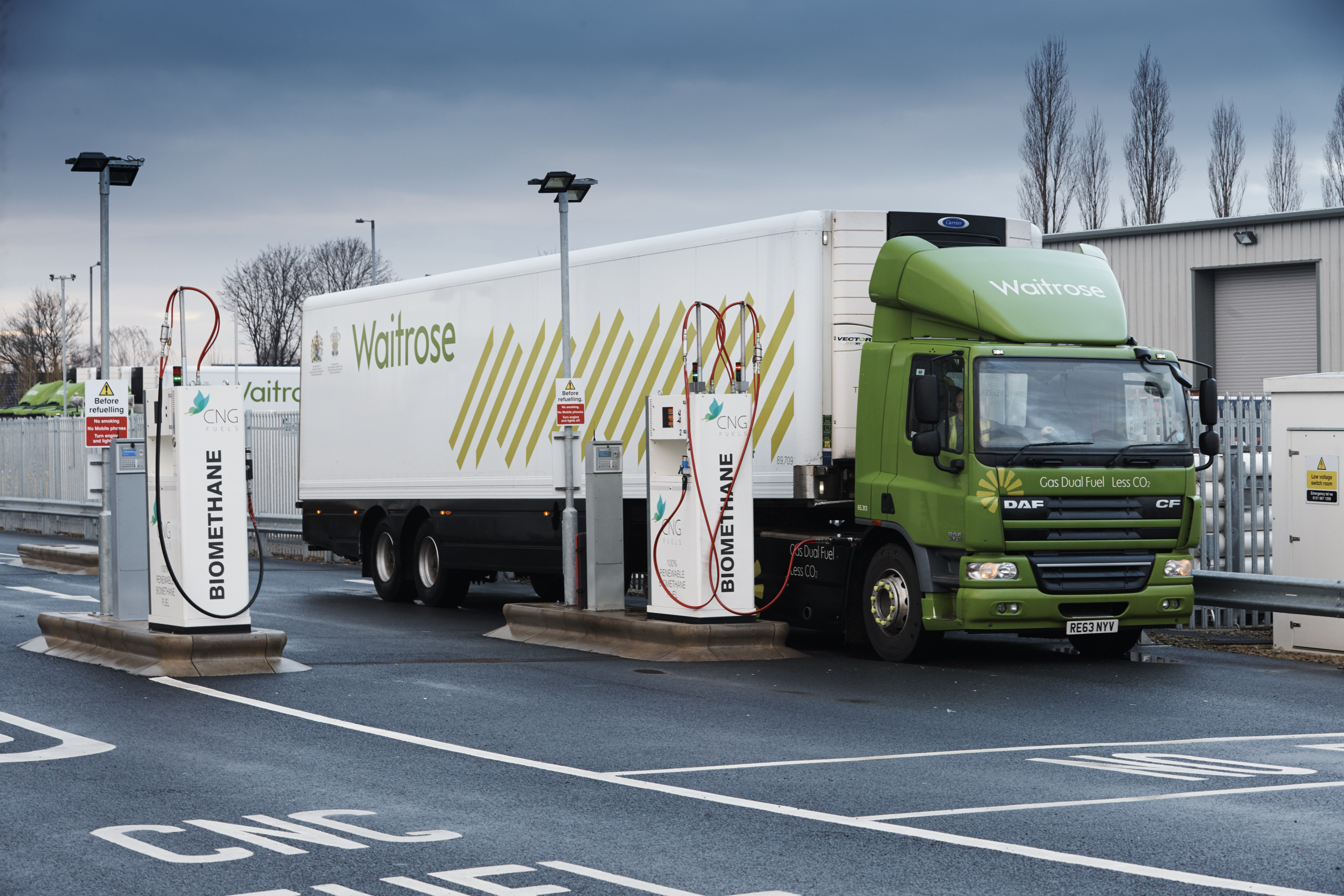Operating a biomethane CNG fleet

Waitrose operates a fleet of trucks which run purely on biomethane CNG, a natural gas sourced from food production waste.
Greenfleet’s Andrea Pluck catches up with Justin Laney, who manages the supermarket’s fleet to find out more.
Waitrose had been using two Scania-built lorries for distribution purposes, which had a range of 350 miles. But since then, the company has bought in ten more of the natural-gas fuelled vehicles, adapted to achieve a new range of 500 miles.
Justin Laney, general manager of Waitrose’s fleet, said: “We currently have 55 gas trucks, which are both duel fuel and dedicated gas.
“Nearly all the gas we use is biomethane CNG and those trucks basically use the same routes that the diesel trucks have,” he added.
The fleet will be used to make deliveries to stores in the midlands and north of England.
Waitrose was assisted by CNG Fuels, a provider of compressed natural gas for commercial vehicles, in a bid to create a fleet of Heavy Goods Vehicles (HGVs) that not only emit less Carbon Dioxide (CO2), but match the range of the diesel trucks that they usually use.
The gas is known to be one of the most cost-effective and lowest carbon alternatives to diesel for HGVs and is about 40 per cent cheaper for fleet operators to use in comparison to diesel. It also has a reduction of up to 83 per cent in carbon emissions, on a “well-to-wheel basis”.
The reason for rolling out naturally-fuelled vehicles, Laney explains, was the combination of lower emissions, a sustainable fuel supply chain, and a good business case.
“It’s a very clean burning gas, so the trucks run quiet and the drivers like it.
“Although we use them for long-distance journeys they would be good to use in inner-city operations.”
EXTENDING THE RANGE
In order to increase the range on the trucks, Waitrose was put into contact with Agility Fuel Solutions and together they expanded the range by 150 miles.
This was achieved by using twin carbon fibre tanks that store gas at 250 bar of pressure. They were mounted onto the sides of the trucks, between the front and rear axle and in total hold about 209kg of CNG when they are full.
The reason behind the expansion was to overcome concerns about the distance that CNG-powered lorries can cover before refuelling, as well as making it easier for fleet operators to switch to gas.
The 26-inch diameter fuel tanks are already in use in the US and were adapted and certified for the European market by Agility Fuel Solutions. This means this is the first time that these tanks will be used in Europe.
REFUELLING
The new trucks, will top up on gas at Waitrose’s Leyland Station, which is operated by CNG Fuels.
It is the first UK station that is connected to the high-pressure grid, and is the highest capacity station in the country. It is capable of providing biomethane for over 500 trucks a day and they also dispense more of the gas into transport than any other UK facility.
Laney went on to say that although there are other filling stations, they don’t dispense biomethane CNG.
He commented: “We’ve actually just won government funding in support of the new fleet and we aim to build another station and have 43 trucks there.”
BENEFITS OF BIO-CNG
The fuel is one of the cleanest and most cost-effective alternatives to diesel and the CNG engines meet the latest Euro 6 quality standards.
In addition to this, refuelling is just as quick as diesel and takes approximately three to five minutes to complete. Also, drivers prefer filling gas to diesel as the process is cleaner.
Although Waitrose’s CNG trucks costs 50 per cent more than the ones that run on diesel, the extra costs should be repaid within two to three years because of fuel savings.
For example, savings should amount to between £15,000 to £20,000 a year, depending on the mileage of the vehicles.
This generates a lifetime saving of between £75,000 to £100,000 and a saving of more than 100 tonnes of CO2 per truck, per year, in comparison to the diesel model.
The CNG trucks are also ideal for urban areas because they are 50 per cent quieter than diesel. This means they cause less noise pollution and can unload goods without causing disruption.
CNG CHALLENGES AND ADVICE
According to Laney, Waitrose were faced with many challenges when developing the CNG vehicles.
He said these ranged from technical issues to sourcing the right tanks and “a lot of regulatory and certification stages to go through”.
Laney went on to say that he had to get the tanks certified and approved to assure safety, whilst making sure the right infrastructure was in place to supply biomethane locally.
Laney’s advice to other fleet managers considering CNG is to have a trial of one of the gas vehicles.
He said: “Companies like Scania, Iveco and CNG fuels would be happy to talk about demonstration vehicles, so speak to one of them to try one of the vehicles and see what you think.
“It’s also important to make sure the right infrastructure is in place to supply biomethane locally.”
Laney continued: “The main thing now, is that after several years, we are finally at a point where a biomethane-fuelled truck is running at the same capacity as our standard diesel truck.
“It’s quite a milestone that could see us looking at replacing more diesel trucks.”
He concluded: “With Europe’s most advanced CNG trucks, we will be able to make deliveries to our stores without having to refuel away from base.
“Using biomethane will deliver significant environmental and operational benefits to our business.
“It’s much cleaner and quieter than diesel, and we can run five gas trucks for the same emissions as one diesel lorry.”






